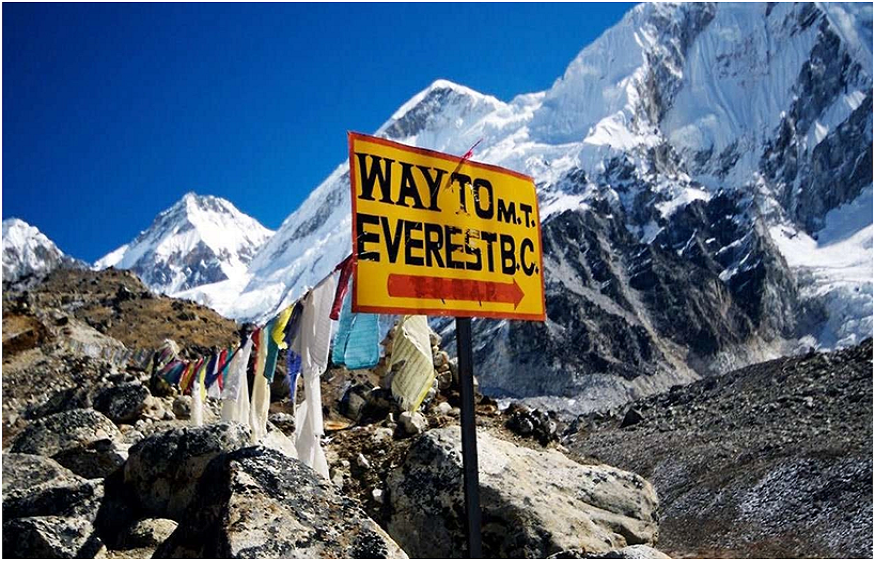The Everest region of Nepal is more than fair a destination—it’s a calling for explorers, nature partners, and social travelers alike. From standing underneath the towering Everest at base camp to flying over ice sheets on a helicopter return, or crossing three high-altitude passes on foot, the treks here offer something for everybody.In this comprehensive guide, we cover four of the most popular Everest trekking options: the Everest Base Camp Trek, EBC Trek with Helicopter Return, the challenging Three Passes Trek, and the well-paced Everest Base Camp Trek – 12 Days. Each trail delivers its own adventure, but all share breathtaking views, Sherpa culture, and the magic of the Khumbu.
1. Everest Base Camp Trek –
Duration: 12–14 Days
Max Altitude: 5,364 meters (17,598 ft)
Best For: First-time trekkers, bucket-list adventurers, scenic and cultural lovers
The classic Everest Base Camp Trek Is a globally cherished journey that leads to the base of the world’s highest mountain, Mt. Everest (8,848.86 m). It’s more than a physical trek—it’s an emotional journey through Sherpa villages, Buddhist monasteries, and ever-changing Himalayan landscapes.
Route Overview
Beginning from a beautiful flight to Lukla, the path leads you through the dynamic Namche Bazaar, past the otherworldly Tengboche Cloister, and into the tall elevated zone of Dingboche and Lobuche. After days of relentless rising, trekkers at long last reach Everest Base Camp and the all encompassing perspective of Kala Patthar (5,545 m), which offers the best close-up views of Everest.
Highlights
- Standing at the foot of Everest
- Exploring the Sherpa capital Namche Bazaar
- Panoramic sunrise at Kala Patthar
- Crossing iconic suspension bridges and rhododendron forests
- Cultural immersion in Khumbu villages
This trek is suitable for moderately fit individuals and can be completed in 12 to 14 days, including acclimatization stops. It’s an achievable dream for anyone passionate about the mountains.
2. Everest Base Camp Trek with Return by Helicopter – Trek Up, Fly Back
Duration: 9–11 Days
Max Altitude: 5,545 meters (Kala Patthar)
Best For: Luxury trekkers, time-conscious adventurers, photographers
For those who want the full experience of trekking to Everest Base Camp but prefer a quicker and more comfortable return, the Everest Base Camp Trek with Helicopter Return offers the perfect combination of adventure and luxury.
Route Overview
The trek follows the same scenic route as the classic EBC trek,driving you step by step through Phakding, Namche, Tengboche, and Dingboche some time recently arriving at Base Camp and Kala Patthar. Instead of following your steps back to Lukla, you board a private helicopter that clears you over the towering crests, valleys, and ice sheets back to Kathmandu.
Highlights
- All the iconic stops of the classic trek
- A thrilling helicopter flight over Everest, Lhotse, Ama Dablam, and Khumbu Glacier
- Saves 3–4 days of descent
- Ideal for trekkers with tight schedules
- Enhanced safety and comfort for the return journey
This hybrid trek is perfect for those who want a unique Himalayan experience without spending extended days on the trail.
3. Three Passes Trek – The Ultimate Everest Circuit Adventure
Duration: 18–21 Days
Max Altitude: 5,535 meters (Kongma La, Cho La, Renjo La)
Best For: Experienced trekkers, high-altitude adventurers, photographers
If you’re looking for the most complete trekking experience in the Everest region, the Three Passes Trek Is your extreme challenge. This journey circles through the Everest Base Camp path whereas crossing three high-altitude passes: Kongma La (5,535 m), Cho La (5,420 m), and Renjo La (5,360 m). It’s requesting, but the rewards are top notch.
Route Overview
The journey begins similarly to the EBC trek but rapidly veers. After coming to Dingboche, trekkers head over Kongma La toward Lobuche and Everest Base Camp. At that point, crossing the frosty Cho La Pass, you enter the excellent Gokyo Valley with its turquoise lakes. At last, you raise Renjo La for clearing and see some time recently returning by means of Thame to Namche.
Highlights
- Three dramatic Himalayan passes above 5,000 meters
- Everest Base Camp and Gokyo Lakes in one trek
- Less-crowded, wild alpine trails
- Views of Everest, Lhotse, Makalu, Cho Oyu, and more
- True immersion into remote high-altitude landscapes
This trek is not for beginners. It demands good physical fitness, proper acclimatization, and mental toughness. But for seasoned trekkers, it’s the Everest region’s crown jewel.
4. Everest Base Camp Trek – 12 Days Itinerary
Duration: 12 Days
Max Altitude: 5,545 meters (Kala Patthar)
Best For: Travelers with limited time, fit and active trekkers
The Everest Base Camp Trek – 12 Days is a compact adaptation of the classic journey, created for those who need to encounter Everest on a more tight plan. It keeps up all key highlights whereas trimming rest and acclimatization days, which makes it more serious but effective.
Route Overview
Beginning from Lukla, the 12-day journey incorporates major stops like Namche Bazaar, Tengboche, Dingboche, Lobuche, EBC, and Kala Patthar. The pace is brisk but reasonable for those with earlier trekking encounters or solid wellness.
Highlights
- Reaches the same iconic destinations as the longer trek
- Ideal for fit adventurers on a short holiday
- Balanced adventure with faster pacing
- Professional guides ensure proper acclimatization despite tighter timeline
Although this version skips one or two acclimatization days, careful guidance and hydration can make it a rewarding and safe experience for physically prepared trekkers.
Choosing the Right Everest Trek: A Visitor’s Guide
All four treks offer Everest views, Sherpa culture, and natural wonders, but the choice depends on your preferences:
| Trek Option | Duration | Difficulty | Unique Feature | Best For |
| Everest Base Camp Trek | 12–14 Days | Moderate | Classic experience | First-time trekkers, cultural travelers |
| EBC Trek with Helicopter Return | 9–11 Days | Moderate | Helicopter return | Luxury and time-conscious travelers |
| Three Passes Trek | 18–21 Days | Challenging | Three high-altitude passes | Experienced trekkers, adventure junkies |
| Everest Base Camp – 12 Days | 12 Days | Moderate–Hard | Faster itinerary | Fit, time-limited trekkers |
Everest Trekking Experience: What to Expect
1. Culture & People
The Everest region is the country of the Sherpa community, known for their amazing mountaineering abilities and warm neighborliness. Along the path, you’ll pass through cloisters, supplication banners, chortens, and little towns that donate profound knowledge into Buddhist conventions.
2. Accommodations & Food
Teahouses are the standard accommodation—modest but comfortable lodges serving hot meals and cozy rooms. Menus include dal bhat (Nepali staple), pasta, soups, momos, and even apple pie in Namche!
3. Fitness & Preparation
While the Everest Base Camp treks are available to numerous, planning is key. Cardiovascular wellness, climbing encounter, and continuous elevation pick up are basic. For the Three Passes Journey, perseverance and mountain status are musts.
4. Altitude Considerations
Altitude sickness is a real concern. All treks include planned acclimatization days, but listening to your body, staying hydrated, and ascending slowly are vital. Always trek with a certified guide.
Best Time to Trek Everest
- Spring (March to May): Clear skies, blooming rhododendrons, ideal trekking temperatures.
- Autumn (September to November): Stable weather, excellent visibility, most popular season.
- Winter (December to February): Cold but fewer crowds. Not recommended for Three Passes due to snow.
- Monsoon (June to August): Risk of landslides and poor visibility—generally avoided.
Trekking Permits for Everest Region
To trek in the Everest region, you’ll need:
- Sagarmatha National Park Permit
- Khumbu Pasang Lhamu Rural Municipality Permit
No TIMS card is required for the Everest region.
Your trekking agency will usually handle all paperwork.
Tips for a Memorable Everest Trek
- Train in advance: Stair climbing, hikes with backpacks, and cardio help.
- Pack light but smart: Layered clothing, good hiking boots, sleeping bag, and altitude medicine.
- Hire a local guide/porter: Not only for safety but also for a richer experience.
- Stay hydrated and eat well: It helps with altitude acclimatization.
- Respect local culture: Dress modestly and follow monastery customs.
Conclusion: Where Every Step Is a Story
No matter which Everest trek you choose—be it the classic route, a helicopter return, the mighty Three Passes, or a 12-day sprint—you’ll return home transformed. These are journeys where legends have walked, where mountains whisper timeless stories, and where your heart finds both challenge and peace.
From panoramic passes to Sherpa warmth, the Everest region is a destination that stays with you forever. Choose your route, lace up your boots, and answer the call of the Himalayas.
FAQs
Q1: Which Everest trek is best for beginners?
A: The classic Everest Base Camp Trek is best suited for beginners with moderate fitness and time for acclimatization.
Q2: Is the helicopter return safe?
A: Yes, it’s safe and operated by experienced pilots. Weather is a key factor, so flexibility is essential.
Q3: How cold does it get on the trek?
A: Temperatures range from 15°C during the day to -15°C at night at higher altitudes. Winter treks can be colder.
Q4: Do I need travel insurance?
A: Yes, and it must include high-altitude evacuation coverage.
Q5: Can I do the trek solo?
A: While solo trekking is allowed (except for the Manaslu region), hiring a guide is highly recommended for safety and local insights.
Booking Process by Adventure Great Himalaya Treks:
To book any of these treks tours through Adventure Great Himalaya A Best Trekking Company In nepal ,To discuss your preferred dates, group size, and specific needs. They will provide a detailed itinerary covering these trek’s duration, highlights, cost, and inclusions such as a guide, porter, meals, accommodation, and transportation.
Prior to the trek, you will receive a comprehensive pre-trek briefing with essential information on packing, fitness preparation, and altitude acclimatization. The agency will finalize all logistical arrangements, including transportation, accommodation, and permits, to ensure everything is in place for your trek. Upon arrival in Nepal, the team will ensure that all aspects of the trek are organized, providing you with a smooth and unforgettable experience on these treks.

